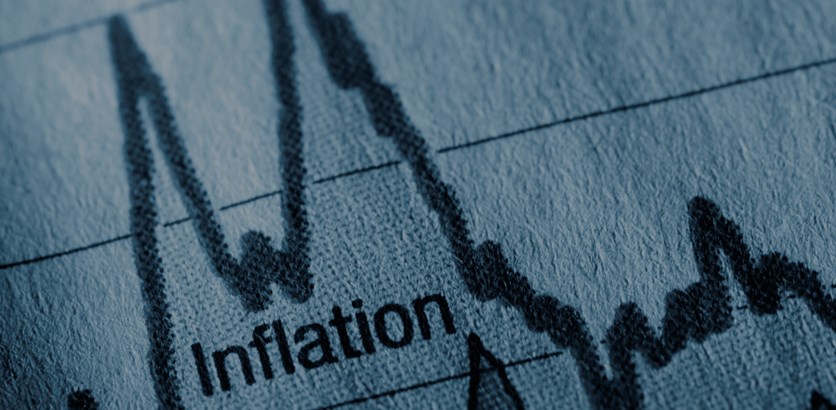To meet growing energy demand and beat climate change, humanity must increase zero emissions energy from nuclear. The Dominion Global Trends Managed Fund is invested in the upside from this major long-term structural trend in energy markets.
The answer to climate change is already here

Let’s start with the bad news on climate change
Climate change is arguably the biggest single structural trend facing the global economy today. The process of burning fossil fuels emits greenhouse gases (primarily carbon dioxide) and these are increasing the earth’s average surface temperatures. Current estimates indicate that without radical action to reduce the burning of fossil fuels, the continued emissions of greenhouse gases will cause catastrophic climate change.
Today, even after decades of heavy investment in renewable energy sources, total global energy supplied by wind and solar represents just 2% of total energy output. Meanwhile fossil fuels still supply 86% of total global energy demand. It is becoming increasingly clear to leading scientists and engineers involved in energy and climate research that renewables (solar & wind) cannot solve the problem of climate change alone.
The chart below shows the mix of total global energy demand since 1970 with forecasts out to 2040. What is clear is just how reliant on fossil fuels (oil, gas and coal) the world still is today, and even worse, how reliant on fossil fuels the world will continue to be in the future. Even with a massive forecast increase in renewable energy investment, with total renewables supply expected to increase by +300%, by 2040 fossil fuels will still represent 71% of global energy demand.

The above forecasts are bad news for climate change. Even with a forecast of aggressive expansion of renewables, the world is expected to be burning record amounts of fossil fuels by 2040. There is a wide gulf between what is needed to reduce global greenhouse gas emissions to tackle climate change versus what is actually happening. The world needs to cut its addiction to fossil fuels and must do it quickly.
Renewable sources like wind and solar only offer part of the solution. These energy sources are greenhouse gas emission free, generating electricity from free fuel sources (wind and solar). Today wind and solar are, in the right locations, cost competitive with fossil fuels. The problem with renewables alone is that they are intermittent sources of energy. There isn’t always sufficient wind to spin wind turbines and the sun doesn’t always shine. A modern electricity grid can have some intermittent sources but it cannot be dependent on intermittent sources. Energy storage could be part of solving this problem but technological progress in energy storage technology has been very slow and we are many decades away from battery technology that can store energy at scale for a modern grid to rely on renewable energy sources alone.
More of this and for longer...
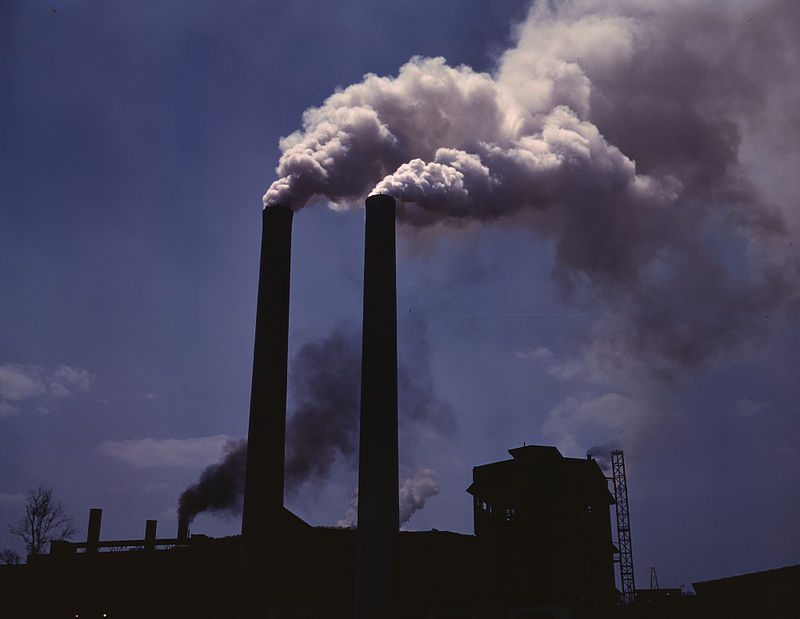
Modern electricity grids require something called base-load power to keep the lights on. Base-load power is a constant high-energy source of energy into an electricity grid that meets the minimum electricity demand of the whole grid. Without base-load power a modern electricity grid cannot function. Historically base-load power has been provided by fossil fuels and nuclear. These power plants can be kept running night-and-day to keep base-load power pumping into the electricity grid. The intermittency of wind and solar means they are not able to provide base-load power to a modern grid.
To combat climate change, the world needs to roll out at scale a source of high-energy base-load power that emits zero greenhouse gases. Alongside renewables, this would dramatically reduce demand for fossil fuels. Without the base-load component, renewables alone will be unable to reduce demand for fossil fuels fast enough for the worst effects of climate change to be mitigated.
And now for the good news!
Nuclear power is the only energy source that can provide base-load high capacity power into a modern electricity grid with zero greenhouse gas emissions. The use of nuclear power today already avoids the emissions of 2 billion tons of greenhouse gases every year. This is because without nuclear power, coal or gas power stations would have to take their place in providing base-load power. This avoids the equivalent of the greenhouse gas emissions from 400 million petrol-driven cars every year.
Uranium (the fuel for nuclear power stations) is incredibly energy dense compared to fossil fuels. Burning 1kg of coal will generate approximately 8kWh of energy, 1kg of oil will generate 12kWh, while the fission of 1kg of uranium will generate 24,000,000 kWh of energy. Uranium has 2 million times the energy density of coal.
The operating costs1o0f0nuclear plants are much lower than other energy sources, as the fuel (uranium) is cheap and energy dense, the lifetime of a plant is long (+60 years) and the load factor of nuclear plants (the % of capacity they operate at over their lifetime) is very high at +90%. When these factors are taken into account, it dramatically lowers the relative lifetime costs of nuclear power versus other energy sources. Over the life of a project, these factors make nuclear power a lot more cost competitive. The chart below shows the range of levelised costs of power generation by energy source and includes capital costs of deployment, lifetime operational costs, and the costs of contingencies needed with renewables to provide Nuclear Natural Gas Onshore Wind Solar Offshore Wind back-up power. Cost comparisons between energy sources like these often fail to include the aforementioned factors, which exaggerate the relative cost benefits of renewables. On these lifetime cost comparisons, nuclear is the most cost competitive source of energy available to electricity grids today.
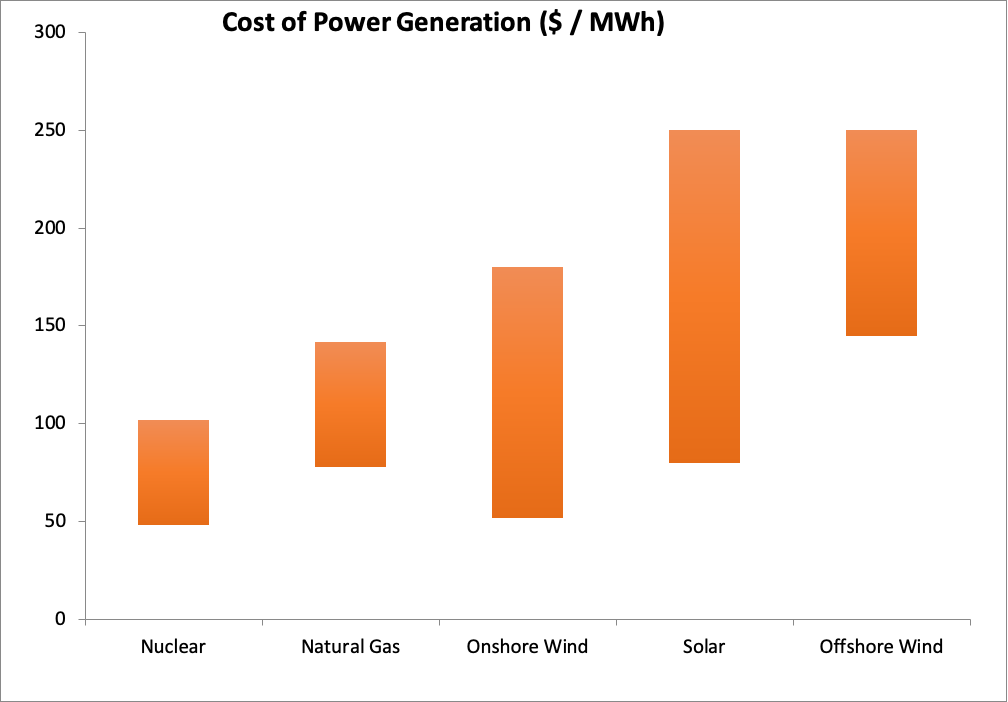
Virtually all of the energy required for the World’s transportation and heating energy requirements is generated from burning fossil fuels. If countries accelerate the process of electrifying these energy sources, i.e. plugging them into the electricity grid rather than relying on fossil fuels, this will require a huge increase in total electricity generation capacity and base-load capacity. This base-load will have to come from somewhere, either fossil fuels or nuclear, there are no other options. Plans for new nuclear will very likely have to be revised up considerably to address this future electricity demand. Renewables alone will be unable to fulfill this future electricity demand increase. Imagine a future economy with everybody arriving home in the evening and charging their electric cars at the same time. This requires base-load power, you cannot provide that power with intermittent renewable sources like wind and solar. To combat climate change you cannot rely on oil, gas or coal for this new future electricity demand. Future nuclear capacity will likely have to be much higher than current industry forecasts indicate to meet new demand from electrifying transportation and heating.
For countries with little domestic access to fossil fuel resources and reliant on importing natural gas or coal, nuclear offers a secure, safe and low-carbon source of energy. This is part of the reason for its popularity as a new source of energy in emerging markets. In fact, while new nuclear projects have been rare in developed world countries, there has been a rapid increase in demand for new nuclear in emerging markets. While penetration of nuclear is low in those markets today, there are ambitious plans in emerging markets to ramp up nuclear capacity. China plans to triple its nuclear capacity by the 2030s. Globally, the number of nuclear reactors currently under construction is at its highest point in 20 years, with significant projects under construction in China, India, Bangladesh, Eastern Europe, and the Middle East.
Despite the nuclear doomsday-talk from many environmental activists in Europe and the US, the long-term future for nuclear is positive, driven by emerging markets and climate change. The gap between perception and reality for the average person on climate change is dramatic, but the numbers do not lie. Germany, for example, still relies heavily on burning lignite coal (the dirtiest form of energy production available) for its electricity. And this is despite spending $600 billion on renewables since 2011. Today Germany has the highest household electricity bills in Europe and it has still failed to cut greenhouse gas emissions, all because of its flawed decision to shutdown its nuclear plants following the 2011 Fukishima accident. The reality of removing nuclear from its grid has been revealed as being flawed. The lesson from Germany is: renewables on their own cannot run a clean electricity grid.
The thinking on nuclear is changing, even among environmentalists. One of the founders of Greenpeace has publicly announced his change of attitude toward nuclear power and he has become a nuclear power advocate. Bill Gates (founder of Microsoft) agrees and he is investing some of his personal fortune into nuclear power to help solve climate change.
Given mankind’s current suite of technologies, it cannot mitigate climate change without nuclear power being a major source of future energy supply, much greater than current energy forecasts imply. As climate change moves up the political agenda in the developed world, the stark reality of the limitations of renewable energy sources will make nuclear an increasingly unavoidable part of the solution (we already have Germany’s failed energy policy as a case study). Meanwhile in emerging markets, where air pollution and demand for reliable electricity is driving massive long-term increases in demand for low pollution and reliable energy, nuclear is already a large part of the solution and could likely be relied on even more as climate change becomes an issue those countries help to solve. For China and India in particular, who both rely on imports of oil and natural gas, nuclear offers a strategic advantage in the supply of reliable base-load power and they are already rolling out ambitious plans for increasing their nuclear power capacity.
Did we mention that nuclear power is safe? No really, it is.
The chart below shows the average number of human deaths that can be linked to different sources of energy production. The numbers are adjusted to show the number of deaths for every TWh of energy produced. These data include all of the deaths that have been attributed to nuclear power accidents (Chernobyl, Fukishima, et al) since the technology was invented. On this metric, nuclear is even safer than solar (deaths linked to accidents from installing or manufacturing solar panels) and wind power (accidents during manufacture or installation of turbines). When compared to coal, still the world’s largest source of base-load power, nuclear is 2,500x safer. Coal air pollution has killed millions of people and continues to kill tens of thousands of people every year globally from respiratory illness. Replacing all coal-fired power stations globally with nuclear would reduce air pollution related deaths by hundreds of thousands over the next two decades. It is estimated that nuclear power has to date saved 2 million lives, having reduced the total amount of coal emissions that would have been emitted without nuclear power. Nuclear power saves lives!
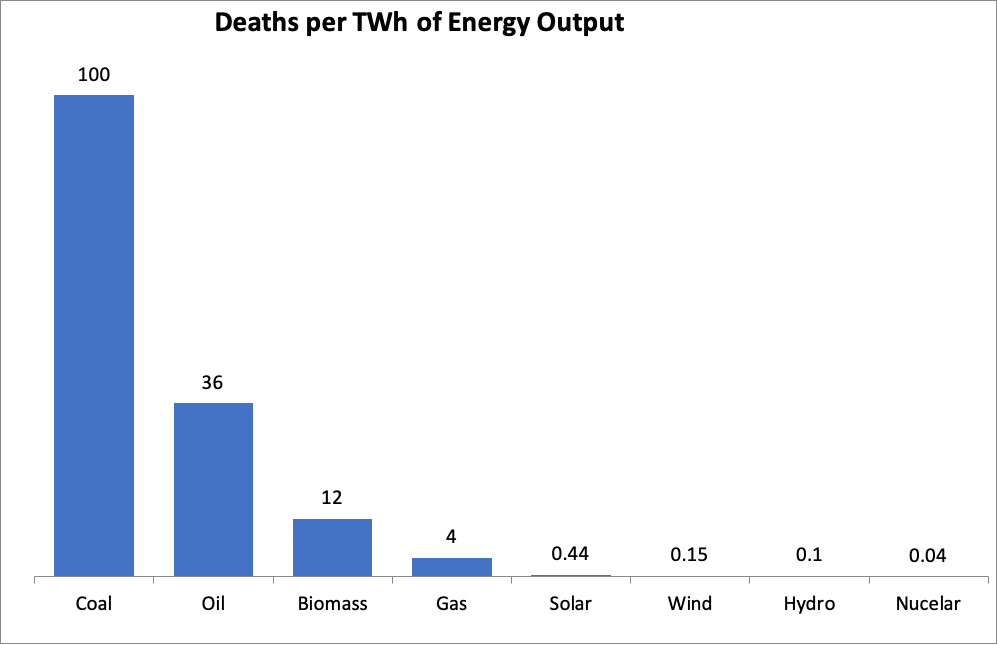
In March 2011, one of the most powerful earthquakes ever recorded struck the east coast of Japan. The earthquake generated a tsunami that killed 15,000 people and caused hundreds of billions of dollars worth of damage. The earthquake and tsunami hit one of Japan’s nuclear reactors located on the east coast of the country, Fukishima, causing a reactor meltdown. Fukishima has joined Chernobyl as a sound bite for the dangers of nuclear power.
Another Japanese nuclear plant called Onagawa was located 60km closer to the epicentre of the earthquake. This plant suffered virtually no damage. The nearby town of Onagawa was destroyed by the quake and tsunami. This nuclear plant’s construction standards and seawall had been upgraded and so the plant withstood one of the most powerful earthquakes in recorded history. In fact the local town’s population were saved by the nuclear plant. They had been trained to seek refuge in the nuclear plant during an earthquake. When the 2011 quake hit, the population of the town sought refuge in the nuclear plant and emerged untouched. Nuclear power saves lives!
How is Dominion investing in this trend?
As climate change becomes an increasingly important political issue, nuclear power’s zero greenhouse gas emissions and high energy density attributes are likely to leave decision makers with little choice other than to invest in new nuclear capacity. This creates significant upside to current industry forecasts for nuclear reactor construction over the next two decades. The rise in demand for electricity from the shift into electric cars and eventually electric heating systems will further exacerbate this energy decision problem, leaving policy makers with the choice of much more fossil fuels (bad for climate change) or more nuclear (good for climate change). Significant policy changes in favour of nuclear in large economies could see a rapid change in sentiment in favour of uranium, the fuel used in nuclear power stations, adding speculative demand to a market which already has supply problems.
All we are saying... is give [nukes] a chance...

Uranium, the fuel for nuclear plants, is a commodity with unique market characteristics that creates an environment for price spikes. Uranium makes up just 5% of on-going operational costs of operating a nuclear plant, compared with 30-40% for coal and gas plants. This makes utilities less likely to respond to low uranium prices by purchasing more uranium, which can exacerbate low prices in the spot uranium market. The currently low uranium spot price has resulted in 10 years of very little investment in new mined uranium production capacity which means the supply-side has little capacity to respond to rises in demand for uranium, increasing the probability of a price spike.
Today, more than 50% of global uranium mine capacity is operating at costs of production above the current uranium spot price. Years of low exploration and mine development spending, combined with the complexities of developing new uranium mine capacity (uranium is radioactive and heavily regulated) leave the uranium supply-side with a low ability to respond to higher prices.
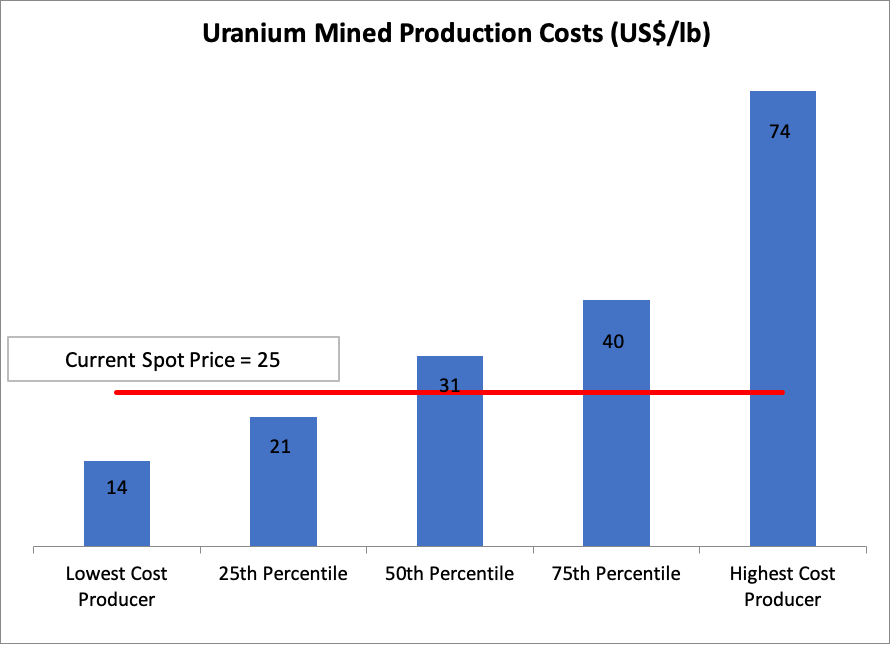
On the demand side, the highest rate of global nuclear reactor construction in 20 years will drive a steady increase in demand for uranium to start and power those reactors, with the net global capacity of nuclear continuing to increase. Conservative estimates of future uranium demand and base case supply forecasts indicate there could be a growing deficit in the supply of uranium in coming years. This could force increasing volumes of uranium demand from utilities onto spot markets. Given the lack of supply-side capacity there could be a considerable spike in uranium prices.
This pattern of uranium price spikes has happened before. The most recent price spike was between 2004 and 2007 with spot prices increasing 10x. A long period of uranium over-supply in the 1990s and 2000s led to underinvestment in new mined capacity and the ability of the supply side to respond to rising demand declined. This culminated in tightening spot markets in 2004 as utilities started coming to market looking to sign new long-term supply contracts for their reactors and there was little capacity available to supply the required uranium. The uranium market today is exhibiting many of the same characteristics as the market in 2004.
The cure for low prices is low prices. Low uranium prices over the past decade have been driven by reactor shutdowns following the Fukishima disaster and Japanese uranium inventories flooding the global market. Japan is now restarting its reactors. As this demand comes back to market and inventories come off market, combined with rising demand from new reactors starting around the world and a tightening supply-side, the perfect storm is brewing for uranium spot prices to rise.
In the Dominion Global Trends Managed Fund, we are currently invested in a basket of three investment names with high exposure to the uranium price. Two of these three (Yellow Cake plc and Uranium Participation Corp) are investment vehicles that own and store processed uranium (yellowcake) in warehouses representing +98% of company net asset value. The third investment idea, Cameco Corp, is the world’s second-largest listed miner and processor of uranium and owns one of the highest quality uranium mines in the world. We believe these investment positions offer investors in the Managed Fund strong long-term exposure to this investment trend and the significant upside in uranium prices.




